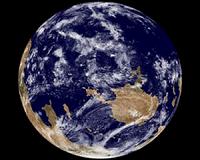 |
Toronto, Canada (SPX) May 25, 2011 Until a recent discovery, theories about the origins and evolutionary relationships of snakes barely had a leg to stand on. Genetic studies suggest that snakes are related to monitor lizards and iguanas, while their anatomy points to amphisbaenians ("worm lizards"), a group of burrowing lizards with snake-like bodies. The debate has been unresolved--until now. The recent discovery by researchers from the University of Toronto Mississauga and the Museum fur Naturkunde Berlin, Germany of a tiny, 47 million-year-old fossil of a lizard called Cryptolacerta hassiaca provides the first anatomical evidence that the body shapes of snakes and limbless lizards evolved independently. "This fossil refutes the theory that snakes and other burrowing reptiles share a common ancestry and reveals that their body shapes evolved independently," says lead author Professor Johannes Muller of Humboldt-Universitat, Berlin. The fossil reveals that amphisbaenians are not closely related to snakes, but instead are related to lacertids, a group of limbed lizards from Europe, Africa and Asia. "This is the sort of study that shows the unique contributions of fossils in understanding evolutionary relationships," says Professor Robert Reisz from the University of Toronto Mississauga, the senior author of the study. "It is particularly exciting to see that tiny fossil skeletons can answer some really important questions in vertebrate evolution". The German research team, led by Muller and American graduate student Christy Hipsley, used X-ray computed tomography to reveal the detailed anatomy of the lizard's skull and combined the anatomy of Cryptolacerta and other lizards with DNA from living lizards and snakes to analyze relationships. Their results showed that Cryptolacerta shared a thickened, reinforced skull with worm lizards and that both were most closely related to lacertids, while snakes were related to monitor lizards like the living Komodo dragons. Even though snakes and amphisbaeans separately evolved their elongate, limbless bodies, the discovery of Cryptolacerta reveals the early stages in the evolution of burrowing in lizards. Comparing Cryptolactera to living lizards with known lifestyles, co-author and U of T Mississauga paleontologist Jason Head determined that the animal likely inhabited leaf-litter environments and was an opportunistic burrower. "Cryptolacerta shows us the early ecology of one of the most unique and specialized lizard groups, and also reveals the sequence of anatomical adaptations leading to amphisbaenians and their burrowing lifestyle," says Head. "Based on this discovery, it appears worm-lizards evolved head first."
Share This Article With Planet Earth
Related Links University of Toronto Explore The Early Earth at TerraDaily.com
 A New View Of An Ancient Habitable Planet
A New View Of An Ancient Habitable PlanetArecibo, Puerto Rico (SPX) May 24, 2011 The Visible Paleo-Earth (VPE), the first collection of photorealistic visualizations of our planet from space in the last 750 million years, has been released by The Planetary Habitability Laboratory (PHL) of the University of Puerto Rico at Arecibo (UPR Arecibo). The VPE visualizations show in real true colors the changes of land and vegetation experimented by Earth in thirty frames start ... read more |
|
| The content herein, unless otherwise known to be public domain, are Copyright 1995-2010 - SpaceDaily. AFP and UPI Wire Stories are copyright Agence France-Presse and United Press International. ESA Portal Reports are copyright European Space Agency. All NASA sourced material is public domain. Additional copyrights may apply in whole or part to other bona fide parties. Advertising does not imply endorsement,agreement or approval of any opinions, statements or information provided by SpaceDaily on any Web page published or hosted by SpaceDaily. Privacy Statement |